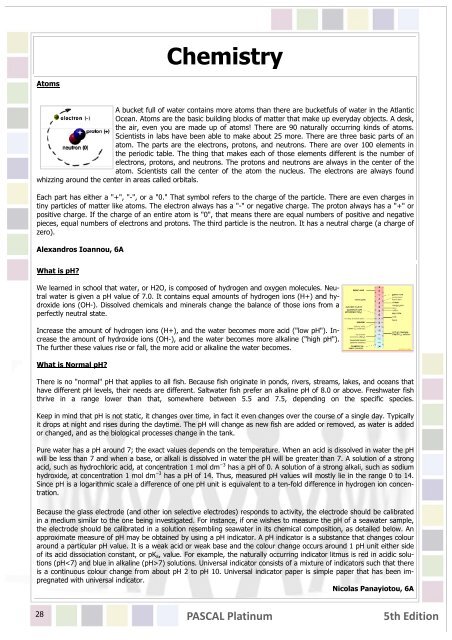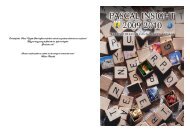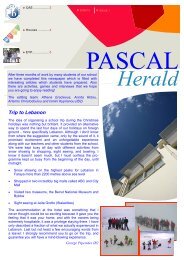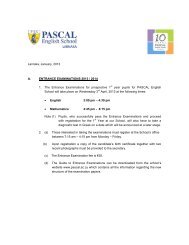PASCAL Platinum 5th Edition
PES_1010.pub (Read-Only) - Pascal Education
PES_1010.pub (Read-Only) - Pascal Education
- No tags were found...
Create successful ePaper yourself
Turn your PDF publications into a flip-book with our unique Google optimized e-Paper software.
ChemistryAtomsA bucket full of water contains more atoms than there are bucketfuls of water in the AtlanticOcean. Atoms are the basic building blocks of matter that make up everyday objects. A desk,the air, even you are made up of atoms! There are 90 naturally occurring kinds of atoms.Scientists in labs have been able to make about 25 more. There are three basic parts of anatom. The parts are the electrons, protons, and neutrons. There are over 100 elements inthe periodic table. The thing that makes each of those elements different is the number ofelectrons, protons, and neutrons. The protons and neutrons are always in the center of theatom. Scientists call the center of the atom the nucleus. The electrons are always foundwhizzing around the center in areas called orbitals.Each part has either a "+", "-", or a "0." That symbol refers to the charge of the particle. There are even charges intiny particles of matter like atoms. The electron always has a "-" or negative charge. The proton always has a "+" orpositive charge. If the charge of an entire atom is "0", that means there are equal numbers of positive and negativepieces, equal numbers of electrons and protons. The third particle is the neutron. It has a neutral charge (a charge ofzero).Alexandros Ioannou, 6AWhat is pH?We learned in school that water, or H2O, is composed of hydrogen and oxygen molecules. Neutralwater is given a pH value of 7.0. It contains equal amounts of hydrogen ions (H+) and hydroxideions (OH-). Dissolved chemicals and minerals change the balance of those ions from aperfectly neutral state.Increase the amount of hydrogen ions (H+), and the water becomes more acid ("low pH"). Increasethe amount of hydroxide ions (OH-), and the water becomes more alkaline ("high pH").The further these values rise or fall, the more acid or alkaline the water becomes.What is Normal pH?There is no "normal" pH that applies to all fish. Because fish originate in ponds, rivers, streams, lakes, and oceans thathave different pH levels, their needs are different. Saltwater fish prefer an alkaline pH of 8.0 or above. Freshwater fishthrive in a range lower than that, somewhere between 5.5 and 7.5, depending on the specific species.Keep in mind that pH is not static, it changes over time, in fact it even changes over the course of a single day. Typicallyit drops at night and rises during the daytime. The pH will change as new fish are added or removed, as water is addedor changed, and as the biological processes change in the tank.Pure water has a pH around 7; the exact values depends on the temperature. When an acid is dissolved in water the pHwill be less than 7 and when a base, or alkali is dissolved in water the pH will be greater than 7. A solution of a strongacid, such as hydrochloric acid, at concentration 1 mol dm −3 has a pH of 0. A solution of a strong alkali, such as sodiumhydroxide, at concentration 1 mol dm −3 has a pH of 14. Thus, measured pH values will mostly lie in the range 0 to 14.Since pH is a logarithmic scale a difference of one pH unit is equivalent to a ten-fold difference in hydrogen ion concentration.Because the glass electrode (and other ion selective electrodes) responds to activity, the electrode should be calibratedin a medium similar to the one being investigated. For instance, if one wishes to measure the pH of a seawater sample,the electrode should be calibrated in a solution resembling seawater in its chemical composition, as detailed below. Anapproximate measure of pH may be obtained by using a pH indicator. A pH indicator is a substance that changes colouraround a particular pH value. It is a weak acid or weak base and the colour change occurs around 1 pH unit either sideof its acid dissociation constant, or pK a , value. For example, the naturally occurring indicator litmus is red in acidic solutions(pH7) solutions. Universal indicator consists of a mixture of indicators such that thereis a continuous colour change from about pH 2 to pH 10. Universal indicator paper is simple paper that has been impregnatedwith universal indicator.Nicolas Panayiotou, 6A28<strong>PASCAL</strong> <strong>Platinum</strong><strong>5th</strong> <strong>Edition</strong>


